During C3 mobility, the students were taught how to use and promote the local cultural heritage in order to set up a business in tourism. They had to work in mixed groups (Italian, Greek and Romanian students) and they did field research to collect data that was used to design a project to set up their own business in tourism.
They found out more about the history and art of Romania and found connections with their local history.
They did research on the customs and traditions of the local community (“momarlani”) that are unique and have deep roots in the Dacians’ times by visiting museums. They saw the traditional architecture from Slatinioara hamlet (old houses made of wood still lived in or abandoned ) and the locals main activities. They interacted with them and sampled local dishes when they visited it.
They learnt Romanian traditional dances and Christmas carols and they shared their knowledge of their local communities to compare them.
During the activity organized on 29 November 2019 at school, when all the students from our school were involved, they had the possibility to sample Romanian food, listen to folk music and folk songs, see traditional dances specific to different regions and ethnic groups from Romania.
The methodology used consisted of:
- field research
- guided visits and educational outings
- analysis and compilation of data and information
- project development simulation
- translation activity in English
- laboratory activities involving the use of ICT
- meetings with representatives of tourism promotion agencies and local companies
- group work
The results of these activities are:
- enriching of the website and of eTwinning project already created;
- improvement of student outcomes in general;
- increase in school relationships with the territory and the local community and of students’ linguistic and ICT skills;
The activities were related with the lessons of school curricula (history, geography, ICT , English etc.) as they had to use their knowledge to make comparisons, to find similarities and differences.
By participating in this activity, students learnt how to do field research, analyse and process data, learn extensive information about the cultural heritage of their region and value it more, collaborate and share information with their colleagues about their common cultural elements, collaborate with local authorities, local community, local tourism companies etc., learn how to develop a business project in tourism in order to develop economically their region, take part in formal and non-formal activities, improve their linguistic and IT skills as well as their behaviour at school.
As for the teachers involved in this project, they learned how to improve their teaching methods, involve and guide students in various activities to develop their critical thinking, IT and linguistic skills, collaborate with the local authorities and local community to help them carry out the planned activities.
Day 1. 28 November 2019
- Welcome ceremony. Meeting with teachers and students. Coordinator’s and headmaster’s discourse. Distribution of the program and badges.
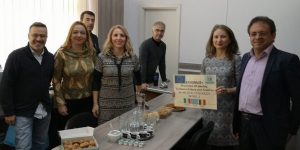
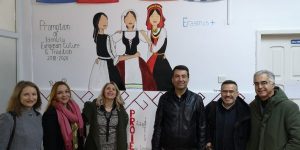
The local press was invited at the activity and they interview some students. The manager of the project also gave an interview and the news appeared at 2 local TV stations:
https://www.facebook.com/hd365tv/videos/633042507228243/
http://mondotv.ro/index.php/stiri/19/n19/item/2735-281119
and in a newspaper: https://cronicavj.ro/wp/?p=93386
- Presentation of “Mihai Eminescu” National College and of the activities done so far in the project (10 min.)
The students from Italy and Greece had the chance to learn new things about the school and about the activities their Romanian colleagues had done. The presentation was uploaded on Twinspace (https://twinspace.etwinning.net/77604/materials/files) The video of the school was also projected and it can be viewed on Twinspace (https://twinspace.etwinning.net/77604/materials/videos).
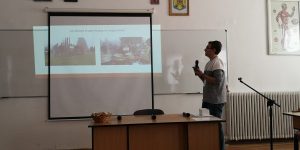
- Presentation of ISTITUTO ISTRUZIONE SUPERIORE “E.MEDI”, LEONFORTE, Italy and of the activities done so far in the project (10 min.)
The Italian students presented their school, so the students who will not go to Italy had the possibility to learn about this school, the activities they do and what they had done so far in the project. The materials prepared by the Italian students were uploaded on Twinspace (https://twinspace.etwinning.net/77604/materials/files) (school presentation, St Joseph Feast).
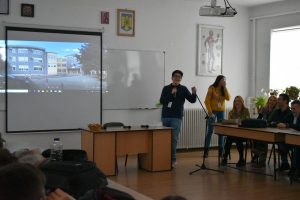
- Presentation of GENIKO LIKIO HORTIATI, GREECE and of the activities done so far in the project (10 min.)
The Greek students presented their school, so the students who hadn’t been to Greece found out where the school is, the profiles they have, the extracurricular activities they do, what their colleagues did in the mobility from Greece in April 2019 and what they had done in the project. The materials were uploaded on TwinSpace (https://twinspace.etwinning.net/77604/materials/files).
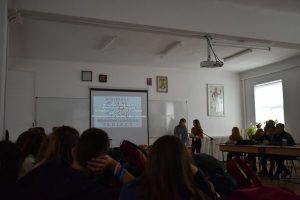
- Presentation of Alphabit Robotics Club (15 min.)
Because in the film of presentation of the school were mentioned all the extracurricular activities and the clubs in which the students from our school are involved, and because the robotics club is a very important one for the prestige of our school due to the awards they have been obtained so far, we considered it was worth giving them the chance to introduce themselves to our guests.
In this way, they could open new possibilities of collaboration in this field with our partners. They introduced themselves, they talked about the awards they have won so far, the competitions they have participated in and their future plans. They also made a short demonstration with one of their robots and taught our guests how to man it.
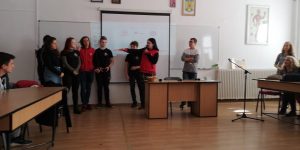
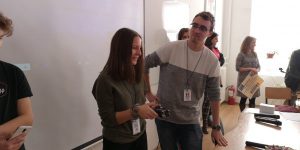
- Patriotic songs and carols- School’s choir coordinated by Mrs. Isabela Vodila, Music teacher
Because on 1st December we celebrate the National Day of Romania, some students from the school choir sang some patriotic songs specific for this period to delight our guests who had the possibility to learn more about our history and culture through songs. Then, because in December we, in Romania, sing mostly carols, they sang some, too. This is a moment of sharing traditional songs with our partners. A video with some of the songs was uploaded on Twinspace (https://twinspace.etwinning.net/77604/materials/videos).
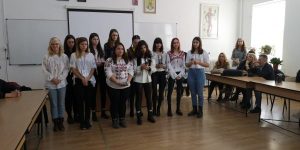
- Presentation of the National Centre for Information and Tourist Promotion in Petrosani Municipality (Mr Maximilian Ganju, representative of National Centre for Information and Tourist Promotion in Petrosani Municipality, and Mrs Stefania Manea, interpreter)
A representative of the National Centre for Information and Tourist Promotion in Petrosani Municipality was invited to present the touristic resources of the Jiu Valley. The aim of this activity was to inform the foreign students about main attractions of the area, the sports they can practice, from where they can obtain information if they come as tourists, the accommodation, means of transport, the fauna and flora of the Parang and Straja Mountains, the competitions organized here to attract tourists etc. He also gave them some postcards with representative species of plants and animals, touristic places and invited them to send them to their parents while they are in Romania. He also talked about their activity of promoting the local touristic resources at different tourism fares.
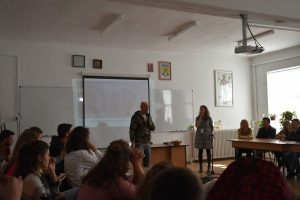
- Local history lesson: Momarlanii in the Jiu Valley- Mr Dorin Raduti, History teacher, and Andrei Voinic, interpreter
The aim of this activity was to teach students about the local people who have been living here for centuries the, connections they have with the Italians and the Greeks, the main activities practised here, the local traditional architecture, local customs and traditions, the geography of the area, the folklore etc. They interacted with the teacher and found similarities and differences between the three cultures. At the end of the activity, they were given a test to evaluate the information acquired during this lesson.

- Visit to University of Petrosani (presentation of the university, presentation of Tourism Economy Faculty, Student Entrepreneurial League presentation, entrepreneurial workshop, presentation of a model of business which promotes local culture and traditions, dividing students into groups)
The aim of this visit was to give students the possibility to learn how to make a business plan in tourism and to learn about the university tradition in our town, what profiles it has and how it prepares students for the labour market.

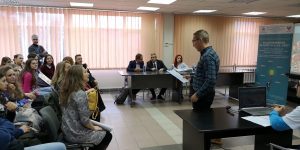
The guests were welcomed traditionally with bread and salt.
Mr Cristian Dobre, assistant lecturer, coordinator of this activity makes a general presentation in which he informs the guests about the programme they are going to have, introduces the speakers and presents the university. Mrs Stefania Manea, coordinator of the project, talked about the project, the aims of the mobility and what the students have to do during these seven days (identify the needs, collect information, take photos etc).
Mr Dobre gave the students guidelines about the steps they have to follow to open a business in tourism. He also gave an example a business plan based on traditional clothing. The students were divided into mixed groups and from now on they were invited to start collecting information.
Mr Radu Sorin, Professor, PhD eng., Rector of the University of Petrosani, talks about the history of the university, the opportunities the students have here, the collaboration with other universities worldwide etc.
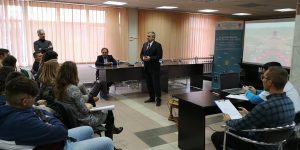
Mrs Oana Ravas, PhD lecturer, talked about the Erasmus + programme at the university level. Two students from this university who have benefitted from this programme talked about this experience and encouraged the high school students to participate when they are at university. In this presentation, the students could realize the importance of participating in such exchanges at a university level.

Our hosts offered us traditional cheese cakes.
- Visit to the geology laboratories of the University of Petrosani
Mr Nimara, PhD Lecturer gave us further information about the university during the guided tour.
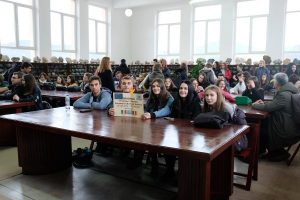
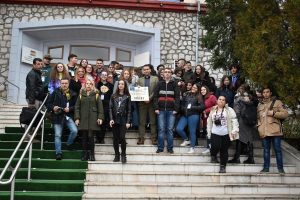
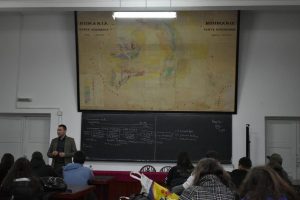
Day 2. 29 November 2019
- 1 December- National Day of Romania- activity at school
On this occasion, the students from Italy and Greece learned how the Romanians celebrate their National Day. The Romanian students from the target group prepared a traditional dance which can be viewed on Twinspace (https://twinspace.etwinning.net/77604/materials/videos). The Italian students sang and danced and the Greek students danced. The videos with the dances and the song can be viewed on Twinspace (https://twinspace.etwinning.net/77604/materials/videos). This was a possibility for them to share their music, songs and dances.
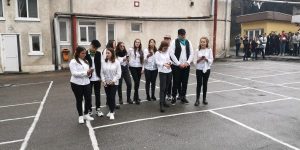
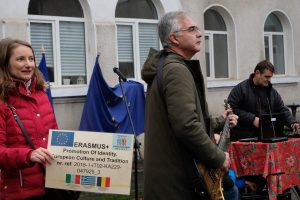
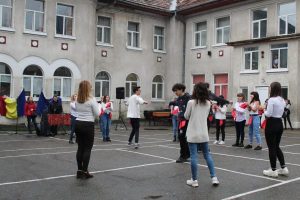
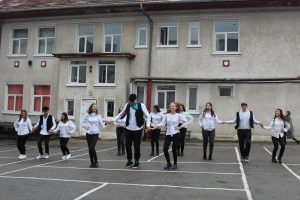
The activity was organized in the school yard where all the students from our school as well as our guests participated. Each class had to prepare a stand, a banner and a dance. A jury assessed their performance and at the end of the activity they were awarded a prize. It is worth mentioning that the activity is organized every year and has a long tradition. A local TV station recorded the whole activity. Videos with dances and songs can be viewed on Twinspace (https://twinspace.etwinning.net/77604/materials/videos).
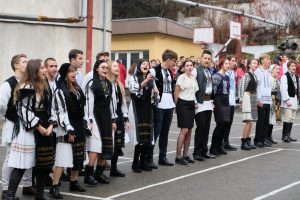
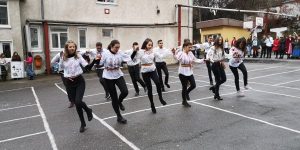
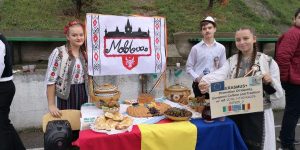
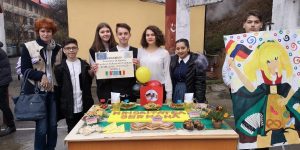
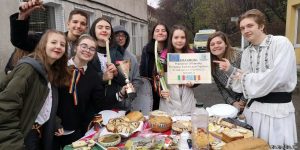
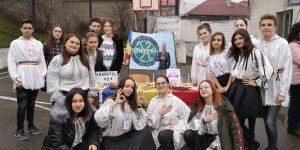
- Visit to Momarlanului Museum
At Momarlanului Museum, the students learned about the way the local people live. Our hosts, Mr Galatan and Mrs Malinesc, welcomed the guests wearing traditional costumes with bread and salt and a traditional alcoholic drink, “palinca”, and traditional cakes with cheese and potatoes and talked about their initiative.
The students learned how two simple people, without being helped by the local authorities, decided to preserve the local customs and traditions by turning a very old house inherited from their relatives into a museum.
This was a data acquisition activity. The students took a lot of pictures on their way to the museum which is situated at about 2 km away from the town centre which they posted on the whatsapp group. On their way to the museum they could see traditional households and see how the local community lives. They also saw the animals they breed and interact with the people. This was a unique experience for the students from Italy and Greece to see this rustic way if living.
When they were in Greece, during C2 mobility, the students visited a similar museum in Panorama. So, they could compare the way the Greek people preserve and promote their culture.
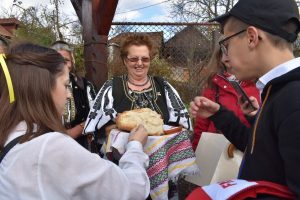
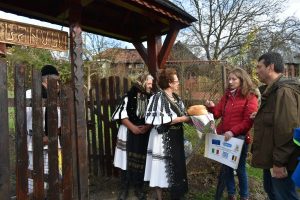
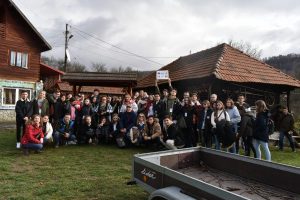
After lunch, the students visited St. Barbara Church and St. Barbara Ethnographic Complex. This was a data acquisition activity which gave them the possibility to learn more about the religious life of the local community, lifestyle, customs and traditions. The priest, Father Tanase, our guide, made a lot of parallels between the Greek, Italian and Romanian religious lives and pointed out the similarities and differences. Two students translated into English his presentation.
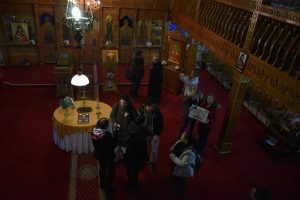
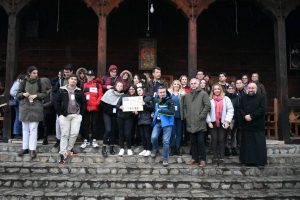
The next landmark visited was Petrila Mine, School Mine and Miner’s Savior Museum where they learned about the mining activity in the Jiu Valley. The aim of this visit was to collect data about the mining activity in this area and to see an example of converting a mine into a museum.
Here, the students learned that Petrila Mine is the oldest mine opened in the Jiu Valley (Romania) and, as a result, a mine where many events took place there during its 156 years of operation, and which employed huge workforce. It is the deepest mine not only in the Jiu Valley, but also in Europe (nearly 1,000 meters in depth, approximately 250 meters below sea level) and had 10 layers of coal in mining. It is one from the last (for the moment) to be closed, being “buried” on October 30, 2015, a few days before 7 years had been commemorated since the last big accident, when 13 miners died (hence the mine got the nickname ‘Death Mine’).
Mr Ion Barbu, a famous Romanian caricaturist, who fought to save the mine which was supposed to be demolished, was present and talked about their activity.
We first visited the former pumping station of the mine which he painted with colourful graffiti, labelling it ‘Pumpadou Center’, which hosted concerts and theatre events. The site was included in the national catalogue of the ‘Museum Night’ event, attracting a lot of visitors.
The guide of the site, the former union leader Catalin Cenusa, now retired, took us to the Mine School. The students learned about the mining activity in Petrila, about the working conditions in mines, about the training a person who wanted to become a miner had to go through.
In the Miner’s Savior Museum, they could see the equipment used to rescue the miners. He also talked about the tragical accidents that took place in Petrila Mine. The students were very impressed and saw how a former mine was turned into a cultural centre.
This was a data acquisition activity (they collected information about the mining activity and took photos).
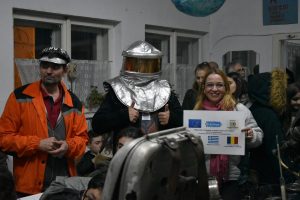
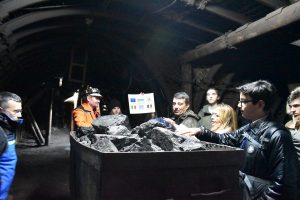
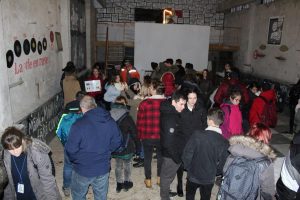
At the end of the day, in the school’s gym, the students were taught by the members of `Junii Petrileni` Folk Group how to dance Romanian traditional dances. Two videos with the activity were posted on Twinspace (https://twinspace.etwinning.net/77604/materials/videos). This is a good example of activity in which the students from all three countries had fun together and shared their customs and traditions. During C2 mobility, the students who participated learnt a traditional Greek dance which they danced on this occasion.
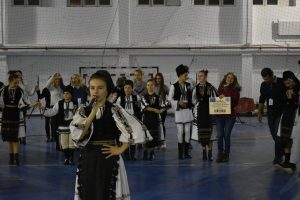
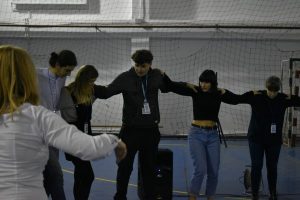
Day 3. 30 November 2019
- Visit to “Retezat” Guesthouse and to the museum (data acquisition) local company that promotes local traditions
The students who were guides here talked about the initiative of the owner, Mr Emil Parau, a local businessman, who invested a lot of money in this business with the aim of promoting the local area with its traditions. They pointed out the activities the tourists can do here and what attracts people. There is an adventure park, the first one in our county, for adventure lovers. For those who love horses, there are some horses they can ride.
The students were impressed by the landscape and the surroundings. The aim of this visit was to collect information about a business that promotes local culture and traditions, which is a good example. The students took photos. The information collected by the students was included in a guide that was uploaded on Twinspace (https://twinspace.etwinning.net/77604/materials/files).
We also visited the museum of ethnography and folklore housed in an old wooden house, that was founded by Mr Parau here and which includes an impressive collection of costumes and objects used by the local people.
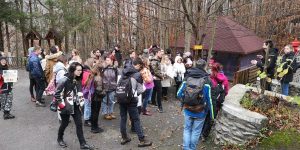
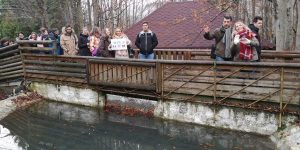
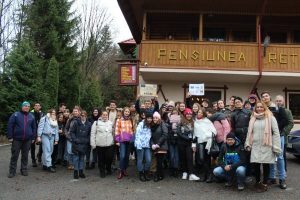

- Visit to Straja Ski Resort and Straja Hermitage (data acquisition)
The data acquisition activity continued in Straja Ski resort. Situated at an altitude of 1445 metres, at about 8 km away from Lupeni, Straka Ski resort is visited by tourists not only in winter, but also in spring or summer. In winter, winter sports lovers, come from all over the country, to ski or snowboard. In spring or summer, those who want to attend rituals unique in Romania, such as the Road of the Cross, before Easter, or visit Straja Hermitage, are welcome here. Two students, who in advance collected information about this resort, were guides here. We also met at Straja Hermitage, Mr Emil Parau, the main investor in tourism in Straja, who spoke about the touristic activities, when he started to invest in tourism, about the history of the place, about the activities the tourists who come in Straja can do etc.
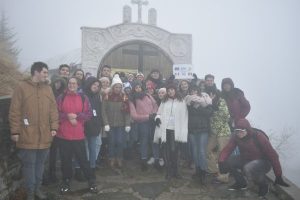
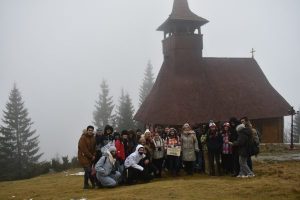

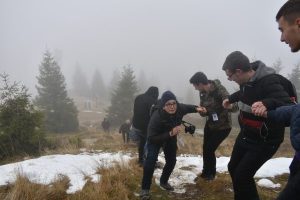
From Lupeni to Straja, we travelled by cable car. This was a unique experience for some students, who have never travelled before by cable car.
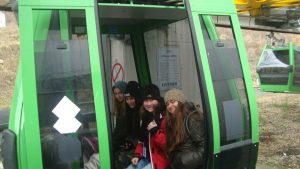
- Visit to Boli Cave
At the end of the day, we visited Bolii Cave, an important landmark in Hunedoara county. Due to its acoustics, every year, in winter, in December, carol concerts are organized. The two guides talked about the discoveries made in this cave and that the Germans decided to film some scenes from the series the “Nibelungen Legend”.
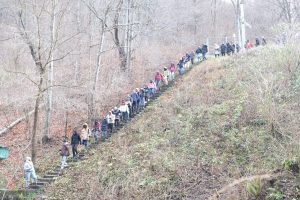
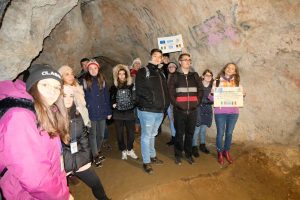
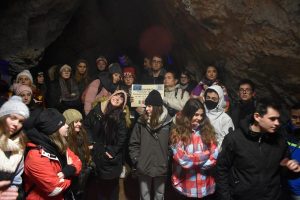
Day 4. 1 December 2019
- Visit to Petrosani Town Hall. Meeting with the Mayor of Petrosani
In the morning, the teachers met the Mayer of Petrosani, Mr Tiberiu Iacob Ridzi. We discussed about the aims of the project and he congratulated us on our initiative of involving students in such exchange programmes. The aim of this meeting was to strengthen the collaboration between the local administration and our schools, on the one hand, and on the other hand, between Petrosani municipality and Leonforte/ Italy and Hortiatis/ Greece.
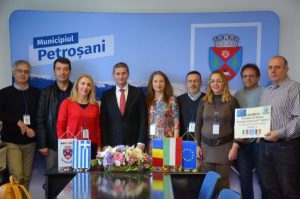
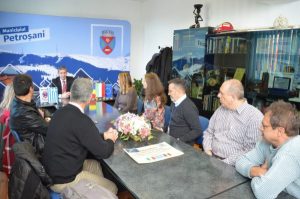
After the meeting with the mayor of Petrosani, in front of the Town Hall we recorded a video in which all the participants say all together, “La Multi Ani, Romania!” The video was uploaded on Twinspace (https://twinspace.etwinning.net/77604/materials/videos).
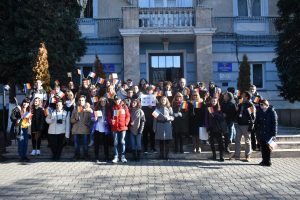
- Visit to Plumber’s Museum
Our guide at the Plumber’s Museum was Mr Roland Szedlacsek. The students were impressed to see an unusual museum, set up by the caricaturist Mihai Barbu. All the exhibits are made by Mr Barbu. The students took a lot of photos and tried to understand the humour behind each exhibit.
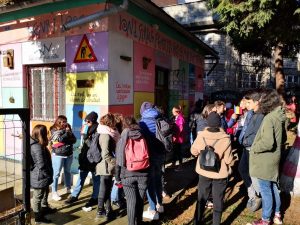
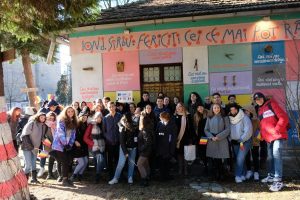
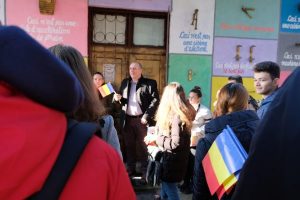
- Local history lesson: 1 December
The history teacher, Mr Dorin Raduti, talked about the significance of the National Day of Romania, its history, draw parallels between the 3 nations, pointed out similarities and differences. Georgiana Pitec, student, was the interpreter. At the end of the lesson, the students took a test paper.
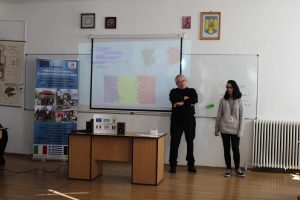
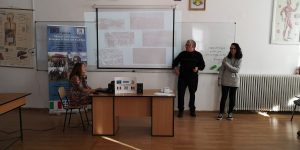
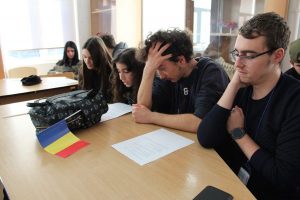
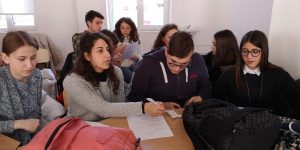
- Cetatea de la Banita- presentation and documentary
Due to difficult relief conditions, we could not visit Banita Fortress. One of the students prepared a presentation which was uploaded on Twinspace (https://twinspace.etwinning.net/77604/materials/files). The students also watched a video made with the drone when some students tried to visit the site.
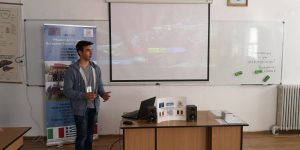
- Learning traditional carols. Translation activity. Group activity
During this activity organized by one of the students from the target group, the students learned about the Christmas customs and traditions, about the similarities between the way this holiday is celebrated in Romania, Italy and Greece, about the Romanian carols. They also learned a Romanian carol and sang other carols. It was an interesting activity which gave students the chance to exchange information. Videos with this activity were uploaded on Twinspace.
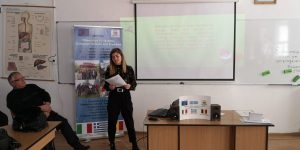
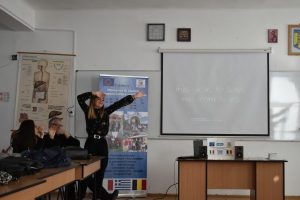
- Buffet with traditional dishes
The students’ parents organized a buffet with traditional dishes. On this occasion, students , teachers and parents sampled traditional Romanian dishes, exchanged recipes, discussed about the similarities and differences between the Romanian, Italian and Greek cuisine.
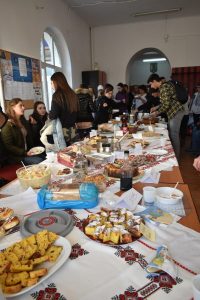
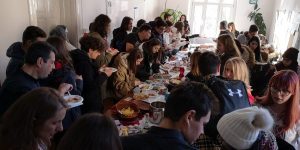
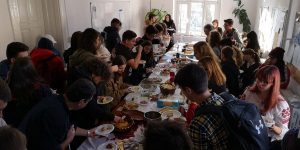
- Project Activity- students
With the data they have collected so far, the students started to work at the projects. They worked in mixed groups (Italians, Greeks and Romanians). Each group consisted of 7 students. They had to fill in the business plan. They were given the business plan presented by Mr Dobre, at the workshop that took place on 28 November 2019, to have an example as well as the criteria used to evaluate their projects.
This activity gave them the chance to know one another better, to practice their English, to share knowledge, the information they had collected so far, to collaborate, to negotiate etc.
- Project Activity- teachers
The teachers discussed about the activities done so far and designed the questionnaire that was given to the students at the end of C3 mobility.
Day 5.2 December 2019
On the bus, on our way to Sibiu, two students talked about Sibiu. All the information that was presented as well as the information about the landmarks visited in Sibiu downtown is included in the guide uploaded on Twinspace (https://twinspace.etwinning.net/77604/materials/files).
- Visit to Muzeul Civilizaţiei Populare Tradiţionale ASTRA- Sibiu
The guide presented some general aspects of the museum (when it was set up, the founder, how it is divided, etc.), some representative buildings from the museum. We included this museum in the list of the activities worth visiting because here are exhibited some households and buildings from the Jiu Valley and Hunedoara county. This was a data acquisition activity.
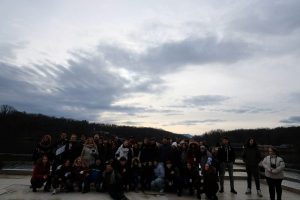
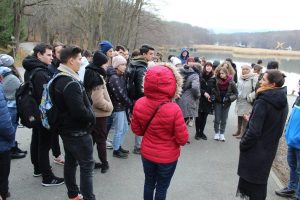
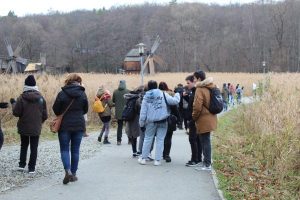
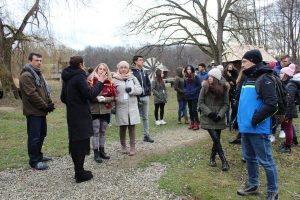
- Visit to Sibiu Downtown
Because Sibiu was in 2007 the European Capital of Culture, we considered it was worth visiting. The Romanian students did some research and found information about the most important landmarks from Sibiu Downtown. In pairs, they presented them to their colleagues. The guide was uploaded on TwinSpace.
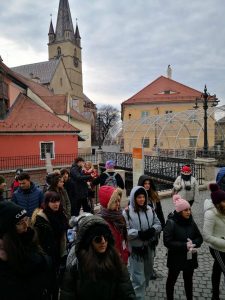
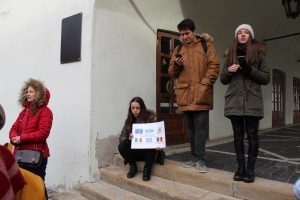
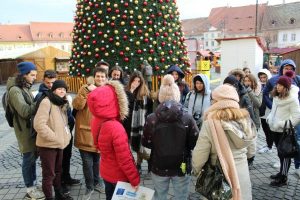
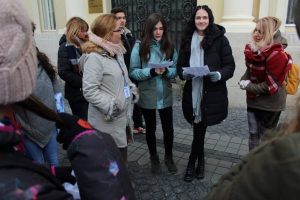

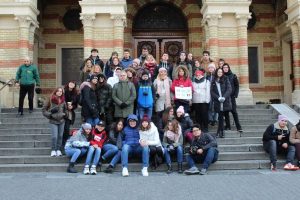
- Visit of Christmas Fair
After lunch, the students were given some free time to visit the Christmas Fair.
At the end of the day, on the way back to Petrosani, the students were given the link of the online test on the whatsapp group whose aim was to evaluate this activity. (https://docs.google.com/forms/d/13CS8eOgyEAEAizEN2La_YT1E8ESIGV-ju6dt9S5ERJ0/edit#responses). The results and the interpretation of the results were posted on Twinspace.
Day 6. 3 December 2019
- Local history lesson: Corvin’s Castle- guided tour
To learn more about our local history, we visited Corvin’s Castle where the guide gave a detailed tour of the castle. We included it in our list because it is one of the largest castles of Europe, which was built by John Hunyadi, Voievode of Transylvania. The guide managed to grasp the visitors’ attention by talking about the legends of the castle (of the fountain in the castle yard, of the raven with the ring in its beak etc.).
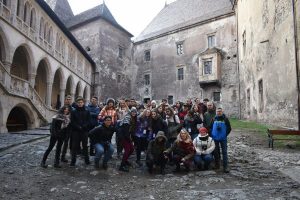
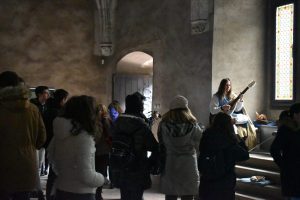
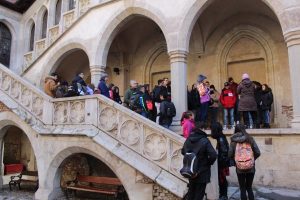
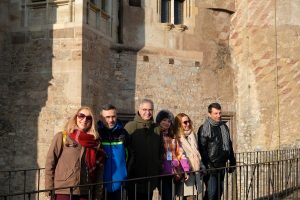
- Local history lesson: Visit to Ulpia Traiana Sarmisegetuza Colony
The curator of the Archaelogical Museum from Sarmisegetuza and of Ulpia Traiana Sarmisegetuza Colony taught the students a very interesting lesson of history about the origins of the Romanian people, the Dacians, the Dacian-Roman Wars, the Roman Conquest, the organization of the Roman Empire in Dacia etc. This was a valuable history lesson for all participants.
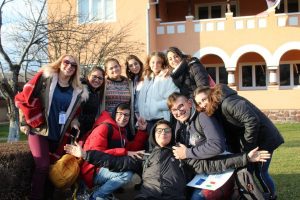
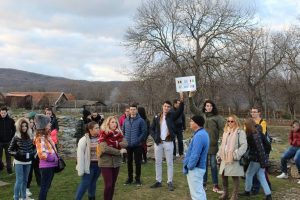
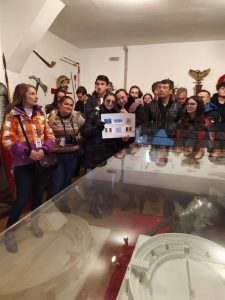
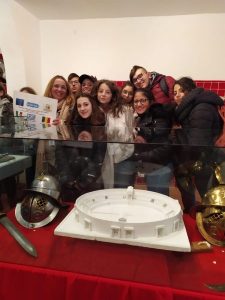
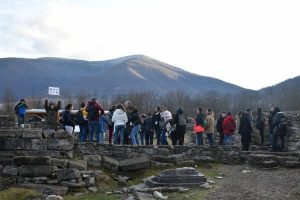
- Local history lesson: St. Nicholas Church- Densus
The priest of St. Nicholas Church- Densus, Father Gherghel talked about one of the oldest churches in Romania, built in 13th century on the site of a 2nd-century Roman temple, with some materials from the Dacian Sarmizegetusa fortress. He pointed out the changes through which the church has gone. This theory places it as the oldest church in Romania, partially based on the fact that the altar is placed south and not east like in typical Christian churches. True or not, this small church sure seems from another world. It also preserves partially the paintings dating from 1443, including a representation of Baby Jesus dressed in a national Romanian costume, an unconventional image for an Orthodox church. This is another reason why it is a church like no other in Romania. Here sermons are still held every Sunday.
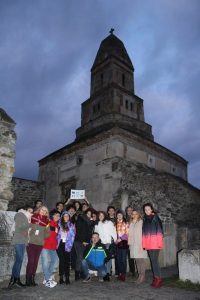
Day 7. 4 December 2019
- Project Activity- students
The students continued to work on the project. The teachers gave them guidelines. They had to finish them and prepare the oral presentation.
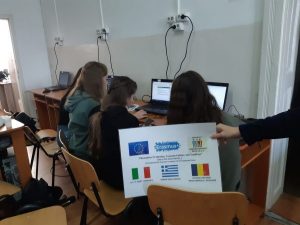
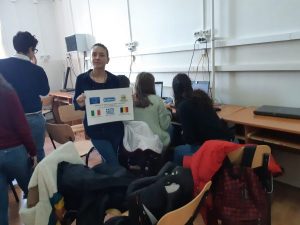
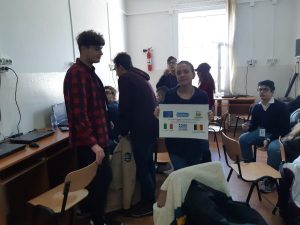
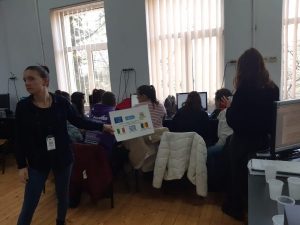
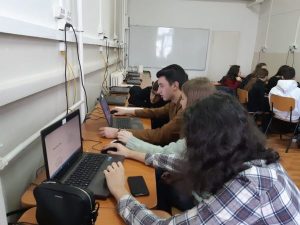
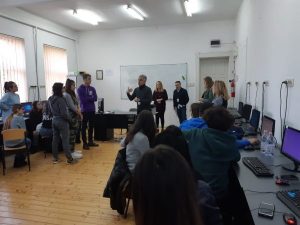
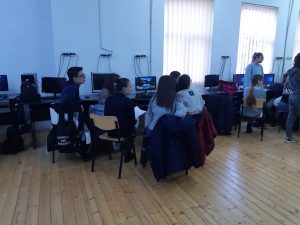
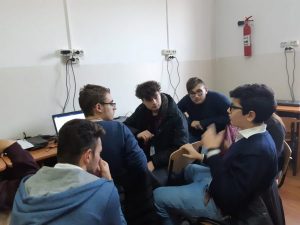
- Project Activity- teachers
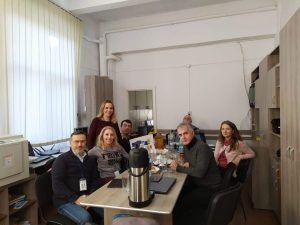
- Project Presentation- University of Petrosani
The students presented their projects in front of the jury that consisted of the professors from the University of Petrosani. It was a challenging activity as most of them had never done this before. They were assessed and each group received a diploma. The projects were uploaded on Twinspace (https://twinspace.etwinning.net/77604/materials/files).
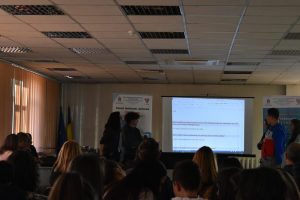
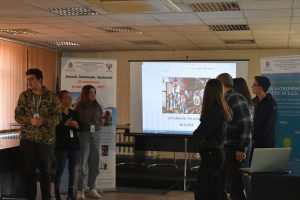
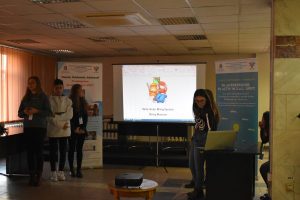
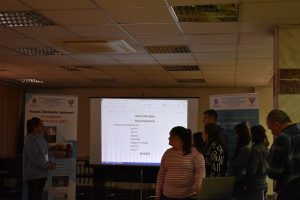
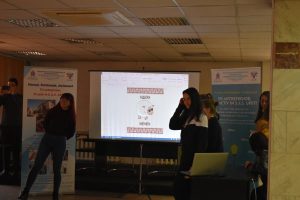

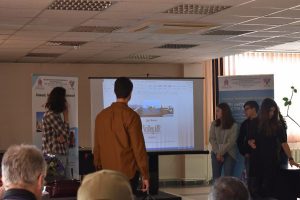
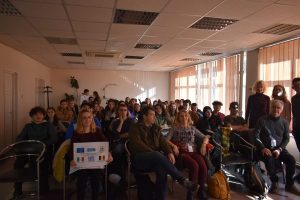
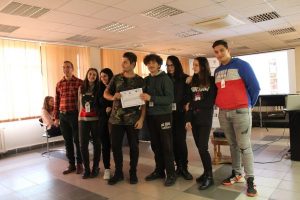
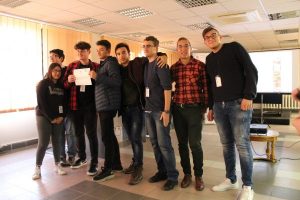
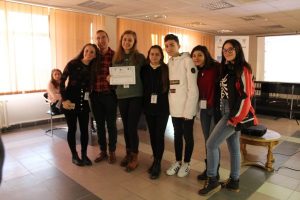
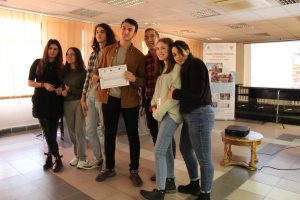
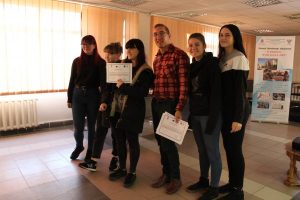
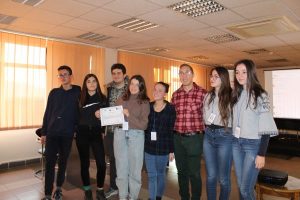
- Closing Ceremony
The ceremony was organized in the Chapel of the Hungarian section of our school.

POST- MOBILITY ACTIVITIES
Dissemination activity:
The C3 mobility was disseminated in the local press (https://www.avantulliber.ro/2019/12/10/proiect-european-erasmus-promotion-of-identity-european-culture-and-tradition-la-colegiul-national-mihai-eminescu-petrosani/).
The coordinator of the project, Mrs Stefania Manea had to make a report for the school inspectorate and Mr Roland Szedlacsek, responsible for dissemination, posted on the school inspectorate of Hunedoara county a report of the C3 mobility (http://forum.isj.hd.edu.ro/viewtopic.php?f=198&t=21075&sid=acdc0e39e9b139b2305444a82d48f717).
Evaluation activity:
The students from Italy and Greece who were involved in this mobility answered a satisfaction questionnaire : https://docs.google.com/forms/d/1HN8CXoHfRnuCxX3oiad69iWtEIW58fkJLmklBzTIRd0/edit?ts=5dea18fb
The answers were uploaded on Twinspace: https://twinspace.etwinning.net/files/collabspace/4/04/604/77604/files/c2fcfee2.pdf



